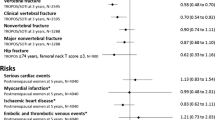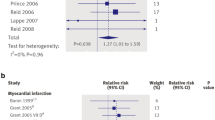Abstract
Recent pooled analyses have shown that strontium ranelate increases the incidence of venous thromboembolism and non-fatal myocardial infarction, but no explanations were given. The aim of our study was to assess the effects a 12-month treatment with strontium ranelate on hemostasis factors and markers of cardiovascular risk in postmenopausal osteoporotic women. Forty osteoporotic postmenopausal women received orally strontium ranelate 2 g daily, plus calcium and colecalcipherol for 12 months. Forty postmenopausal osteopenic women matched for age, menopausal age, and body mass index served as controls and received orally calcium and colecalcipherol for 12 months. Biochemical cardiovascular risk factors and hemostatic indices were assayed prior to treatment, and after 3, 6, and 12 months of therapy. These indices included fibrinogen, fasting glucose, total serum cholesterol, high-density lipoprotein cholesterol, low-density lipoprotein cholesterol, triglycerides, plasma levels of D-dimer, homocysteine, partial thromboplastin time, and prothrombin time. In addition, we evaluated possible changes in blood pressure and occurrence of venous thromboembolic events. At baseline, no statistically significance was observed between the two groups except for bone mineral density at lumbar spine, femoral neck, and total femur, which was lower in strontium ranelate group. After 12 months of treatment, there was no statistically significant change in cardiovascular risk factors and hemostatic parameters. None of the 40 women developed any clinical venous thromboembolic event. A 12-month treatment with strontium ranelate did not alter hemostasis factors or markers of cardiovascular risk, suggesting that reported increased risk of venous thromboembolism and myocardial infarction with strontium is mediated by other factors.




Similar content being viewed by others
References
P.J. Meunier, C. Roux, E. Seeman, S. Ortolani, J.E. Badurski, T.D. Spector et al., The effects of strontium ranelate on the risk of vertebral fracture in women with postmenopausal osteoporosis. N. Engl. J. Med. 350, 459–468 (2004)
J.Y. Reginster, D. Felsenberg, S. Boonen, A. Diez-Perez, R. Rizzoli, M.L. Brandi et al., Effects of long-term strontium ranelate treatment on the risk of nonvertebral and vertebral fractures in postmenopausal osteoporosis: results of a five-year, randomized, placebo-controlled trial. Arthritis Rheum. 58, 1687–1695 (2008)
J.Y. Reginster, E. Seeman, M.C. De Vernejoul, S. Adami, J. Compston, C. Phenekos et al., Strontium ranelate reduces the risk of nonvertebral fractures in postmenopausal women with osteoporosis: treatment of Peripheral Osteoporosis (TROPOS) study. J. Clin. Endocrinol. Metab. 90, 2816–2822 (2005)
E. Seeman, J.P. Devogelaer, R. Lorenc, T. Spector, K. Brixen, A. Balogh et al., Strontium ranelate reduces the risk of vertebral fractures in patients with osteopenia. J. Bone Miner. Res. 23, 433–438 (2008)
J.Y. Reginster, J.M. Kaufman, S. Goemaere, J.P. Devogelaer, C.L. Benhamou, D. Felsenberg et al., Maintenance of antifracture efficacy over 10 years with strontium ranelate in postmenopausal osteoporosis. Osteoporos. Int. 23, 1115–1122 (2012)
J.M. Kaufman, M. Audran, G. Bianchi, V. Braga, M. Diaz-Curiel, R.M. Francis et al., Efficacy and safety of strontium ranelate in the treatment of osteoporosis in men. J. Clin. Endocrinol. Metab. 98(2), 592–601 (2013)
C. Cooper, J.Y. Reginster, R. Chapurlat, C. Christiansen, H. Genant, N. Bellamy et al., Efficacy and safety of oral strontium ranelate for the treatment of knee osteoarthritis: rationale and design of randomised, double-blind, placebo-controlled trial. Curr. Med. Res. Opin. 28, 231–239 (2012)
J.P. Pelletier, C. Roubille, J.P. Raynauld, F. Abram, M. Dorais, P. Delorme et al., Disease-modifying effect of strontium ranelate in a subset of patients from the Phase III knee osteoarthritis study SEKOIA using quantitative MRI: reduction in bone marrow lesions protects against cartilage loss. Ann. Rheum. Dis. 74, 422–429 (2015)
Protelos. Summary of Product Characteristics. Servier Labs. http://emc.medicines.org.uk/emc/assets/c/html/displaydoc.asp?documentid=15410. Accessed 21 Aug 2006
EMEA Protelos Scientific Discussion (2005), http://www.emea.eu.int/humandocs/PDFs/EPAR/protelos/121604en6.pdf. Accessed 21 Aug 2006
B. Abrahamsen, E.L. Grove, P. Vestergaard, Nationwide registry-based analysis of cardiovascular risk factors and adverse outcomes in patients treated with strontium ranelate. Osteoporos. Int. 25, 757–762 (2014)
M. Halil, M. Cankurtaran, B.B. Yavuz, Z. Ulger, S. Piskinpasa, A. Gedik, I.C. Haznedaroglu, S. Kirazli, S. Ariogul, Short-term hemostatic safety of strontium ranelate treatment in elderly women with osteoporosis. Ann. Pharmacother. 41(1), 41–45 (2007)
Z. Ulger, E.I. Gurel, M. Halil, G. Oozen, I. Kalan, N. Seringec et al., Hemorheological changes with strontium ranelate treatment do not seem to be related to its claimed prothrombotic effects. Arch. Gerontol. Geriatr. 54, 218–221 (2012)
W.T. Friedewald, R.I. Levy, D.S. Fredrickson, Estimation of the concentration of low-density lipoprotein cholesterol in plasma, without use of the preparative ultracentrifuge. Clin. Chem. 18, 499–502 (1972)
European Medicines Agency. Assessment report—periodic safety update report (EPAR—Protelos-H-C-560-PSU31). (2014), www.ema.europa.eu/docs/en_GB/document_library/EPAR_-_Assessment_Report_-_Variation/human/000560/WC500147168.pdf. Accessed 3 Feb 2014
B. Abrahamsen, E.L. Grove, P. Vestergaard, Nationwide registry-based analysis of cardiovascular risk factors and adverse outcomes in patients treated with strontium ranelate. Osteoporos. Int. 25(2), 757–762 (2014)
European Medicines Agency European Medicines Agency recommends that Protelos/Osseor remain available but with further restrictions (2014), http://www.ema.europa.eu/ema/index.jsp?curl=pages/medicines/human/referrals/Protelos_and_Osseor/human_referral_prac_000025.jsp&mid=WC0b01ac05805c516f. Accessed 24 Feb 2014
S.M. Saadeddin, M.A. Habbab, G.A. Ferns, Markers of inflammation and coronary artery disease. Med. Sci. Monit. 8(1), RA5–RA12 (2002)
W.B. Kannel, P.A. Wolf, W.P. Castelli, D’Aquistino RB Fibrinogen and the risk of cardiovascular disease: the Framingham study. J. Am. Med. Assoc. 258, 1183–1186 (1987)
Y. Shi, Y. Wu, C. Bian, W. Zhang, J. Yang, G. Xu, Predictive value of plasma fibrinogen levels in patients admitted for acute coronary syndrome. Tex. Heart Inst. J. 37, 178–183 (2010)
W.K. Lagrand, C.A. Visser, W.T. Hermens, H.W. Niessen, F.W. Verheugt, G.J. Wolbink et al., C-reactive protein as a cardiovascular risk factor more than an epiphenomenon? Circulation 100, 96–102 (1999)
P.M. Ridker, High-sensitivity C-reactive protein and cardiovascular risk: rationale for screening and primary prevention. Am. J. Cardiol. 92, 17K–22K (2003)
G. Ndrepepa, S. Braun, T. Tada, L. King, S. Cassese, M. Fusaro et al., Comparative prognostic value of C-reactive protein & fibrinogen in patients with coronary artery disease. Indian J. Med. Res. 140, 392–400 (2014)
H. Tanriverdi, H. Evrengul, Y. Enli, O. Kuru, D. Seleci, S. Tanriverdi et al., Effect of homocysteine-induced oxidative stress on endothelial function in coronary slow-flow. Cardiology 107, 313–320 (2007)
M.A. Banos-Gonzalez, E. Angles-Cano, G. Cardoso-Saldana, M.A. Pena-Duque, M.A. Martinez-Rios, B. Valente-Acosta et al., Lipoprotein(a) and homocysteine potentiate the risk of coronary artery disease in male subjects. Circ. J. 76, 1953–1957 (2012)
N. Khandanpour, Y.K. Loke, F.J. Meyer, B. Jennings, M.P. Armon, Homocysteine and peripheral arterial disease: systematic review and meta-analysis. Eur. J. Vasc. Endovasc. Surg. 38, 316–322 (2009)
H. Kumakura, H. Kanai, Y. Araki, Y. Hojo, S. Kasama, H. Sumino et al., Differences in brain natriuretic peptide and other factors between Japanese peripheral arterial disease patients with critical limb ischemia and intermittent claudication. J. Atheroscler. Thromb. 20, 798–806 (2013)
C. Diehm, J.R. Allenberg, D. Pittrow, M. Mahn, G. Tepohl, R.L. Haberl et al., Mortality and vascular morbidity in older adults with asymptomatic versus symptomatic peripheral artery disease. Circulation 120, 2053–2206 (2009)
E.J. Dunn, P.J. Grant, Type 2 diabetes: an atherothrombotic syndrome. Curr. Mol. Med. 5, 323–332 (2005)
P. Aukrust, T. Waehre, J.K. Damas, L. Gullestad, N.O. Solum, Inflammatory role of platelets in acute coronary syndromes. Heart 86, 605–606 (2001)
G.K. Hansson, Inflammation, atherosclerosis, and coronary artery disease. N. Engl. J. Med. 352, 1685–1695 (2005)
K.K. Koh, R. Mincemoyer, M.N. Bui, G. Csako, F. Pucino, V. Guetta et al., Effects of hormone-replacement therapy on fibrinolysis in postmenopausal women. N. Engl. J. Med. 336, 683–690 (1997)
A. Zampetaki, P. Willeit, L. Tilling, I. Drozdov, M. Prokopi, J.M. JM et al., Prospective study on circulating microRNAs and risk of myocardial infarction. J. Am. Coll. Cardiol. 60, 290–299 (2012)
J.L. Januzzi Jr, ST2 as a cardiovascular risk biomarker: from the bench to the bedside. J. Cardiovasc. Transl. Res. 6, 493–500 (2013)
R.K. Upadhyay, Emerging risk biomarkers in cardiovascular diseases and disorders. J Lipids. 2015, 971453 (2015). doi:10.1155/2015/971453
Author information
Authors and Affiliations
Corresponding author
Ethics declarations
Conflict of interest
The authors declare that they have no conflict of interest.
Rights and permissions
About this article
Cite this article
Atteritano, M., Catalano, A., Santoro, D. et al. Effects of strontium ranelate on markers of cardiovascular risk in postmenopausal osteoporotic women. Endocrine 53, 305–312 (2016). https://doi.org/10.1007/s12020-015-0721-8
Received:
Accepted:
Published:
Issue Date:
DOI: https://doi.org/10.1007/s12020-015-0721-8




